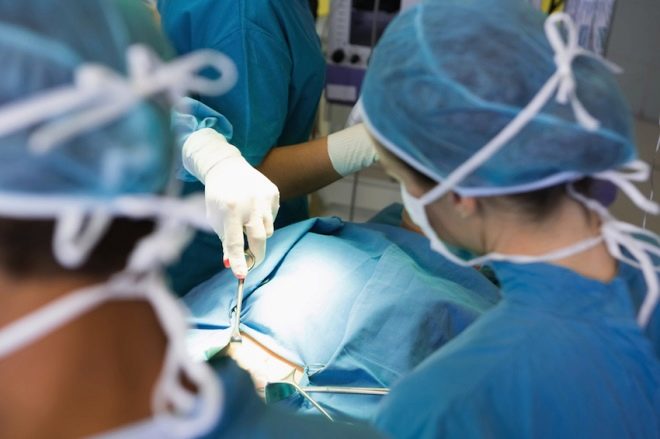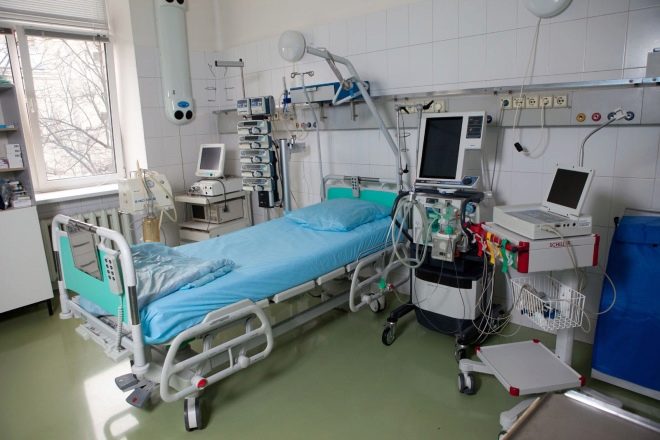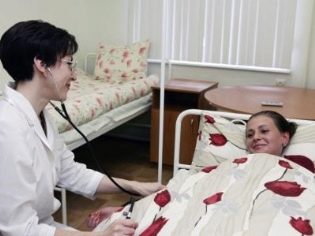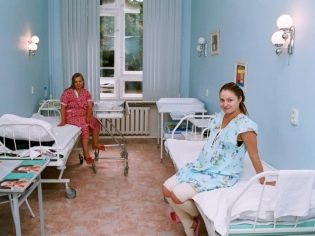How many days after cesarean section are they allowed to get up and how to do it correctly?
Pregnant women who are to undergo a caesarean section, according to certain indications, quite reasonably care whether the recovery process of the body after the operation is painful and lengthy. It is this that often scares future mothers who are shown a planned cesarean section.
In this article we will talk about when, after surgical labor, you can get up, walk and how to do it correctly.
After operating
The woman who just had a caesarean section needs special care and control. Therefore, after the end of the surgery, it is immediately transported to the intensive care unit.
In it it should lie for several hours, and if complications appear, then several days. Medical workers monitor the level of pressure, the temperature of the puerperal, injecting reducing drugs by the hour. They are necessary, since the uterus' own involution after a surgical incision is slow, which is fraught with infections.
So that the pain, after the anesthesia finally passes, is tolerable, the introduction of painkillers is envisaged, if there are signs or fears of infection, antibiotics are immediately introduced. Hot water bottles with ice are applied on the stomach for better uterine contraction. It is clear that in the conditions of the intensive care unit no movements are welcomed, except for the movements of the hands and head, and even that is very limited.
If there are no complications, after 4-6 hours a woman can be transferred to a regular ward in the ward. On the first day of the child can only bring for feeding. Leaving it with the mother, if the maternity hospital routine implies the joint stay of the newly-made mothers and newborns, will be only when the woman stands up after a cesarean section.
Time to get up
The sooner a woman begins to join the motor activity after being transferred to a regular ward, the better. Forecasts for faster and more successful recovery will be higher. But this does not mean that you can immediately get up and go.
Only 5-6 hours after the operation, a woman can start tossing and turning from side to side, but not yet rise. It will hurt, but not as much as it seems. The pain itself is dull, because a woman will be given painkillers intramuscularly for another 2-3 days. First by the hour, then by request. Stronger pain in this case is fear. Mothers are afraid that the seams will disperse, burst. This need not be afraid. Although it is rather difficult to ignore the pulling sensations that create stitches when trying to turn on its side.
Tossing and turning to the side is necessary - first, the woman tries to turn her upper body, shoulder girdle, and then smoothly, gradually pulls up her lower body, holding the bandage on her stomach with her hand. The first coups will bring a lot of unpleasant moments, but with each subsequent it will get better.
After 8-10 hours after the end of the operation, if there are no complications and strict instructions of the doctor regarding the need to lie down and not move, you can get up. But before you can take a more or less upright position (it is usually conditionally vertical, since the puerperal is the letter "G", unable to straighten), you need to learn to sit.
From the prone position, which has already been mastered, you need to gently lower one leg from the bed, lie down for some time, and then, holding the stomach with your palm and leaning your second hand on the bed, slowly sit down. Do not rush to get up immediately. Sit for half an hour, an hour, until dizziness passes, which is completely normal after surgery and anesthesia.
Once in a sitting position it becomes quite comfortable, you can try to get up. If there is someone in the chamber who can help to do this, take advantage of this opportunity. If not, then lean your hands on the headboard, on the edge of the bed, as comfortable. Do not try to straighten your shoulders and back as soon as you manage to be on your own two feet. It will be quite painful.
Do not go far from the bed or the attendant, stick to the wall or the headboard, because the first steps may be accompanied by an attack of strong sudden weakness, dizziness. Without insurance in the form of a close, roommate, nurse or, in extreme cases, the back of the bed, the puerperal may fall and be injured.
The next day after the operation, women usually move around the ward quite tolerably well, and another day without any special problems they go to the toilet themselves, walk along the corridor, and can take care of the babies themselves with the observance of precautions. Wearing a postoperative bandage facilitates the early postoperative period, but be sure to consult your doctor before putting it on.
Can there be complications?
An incorrect mode of physical activity could theoretically cause seam divergence, a violation of the structure of internal sutures. Subsequently, such a scar may be untenable, making it harder to bear the next pregnancy.
But a long stay in bed, if a woman is afraid to get up and walk, can have very negative consequences - the uterus begins to contract worse, the release of postpartum bleeding and clots is difficult, which increases the likelihood of infection, endometritis.
The algorithm for correct recovery after surgery is presented in the next video.


















